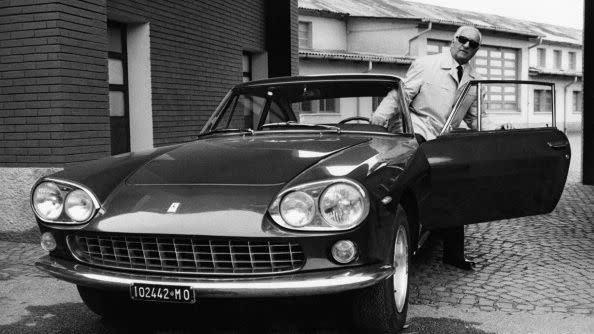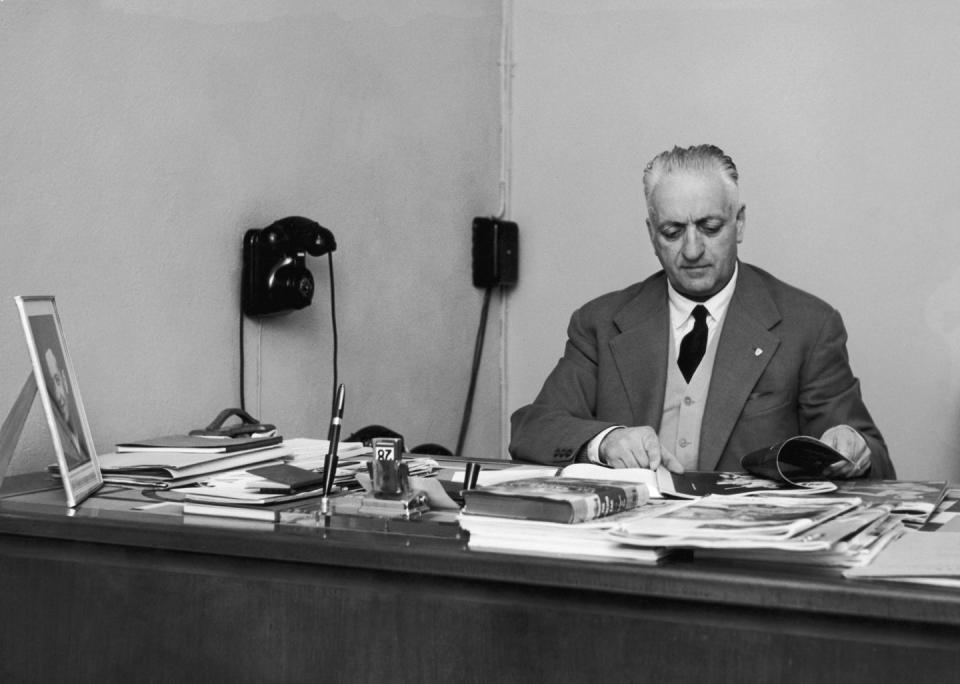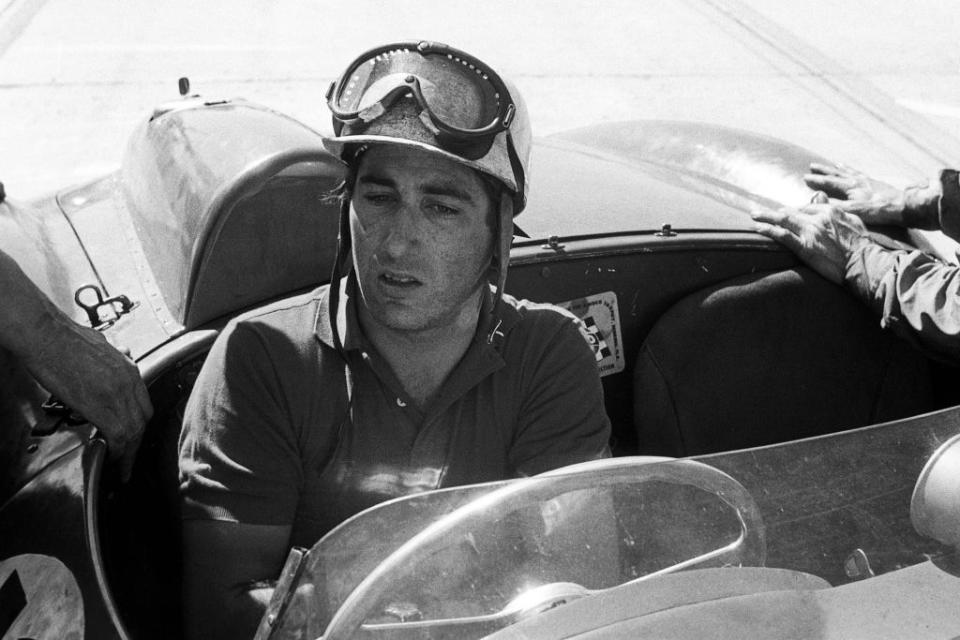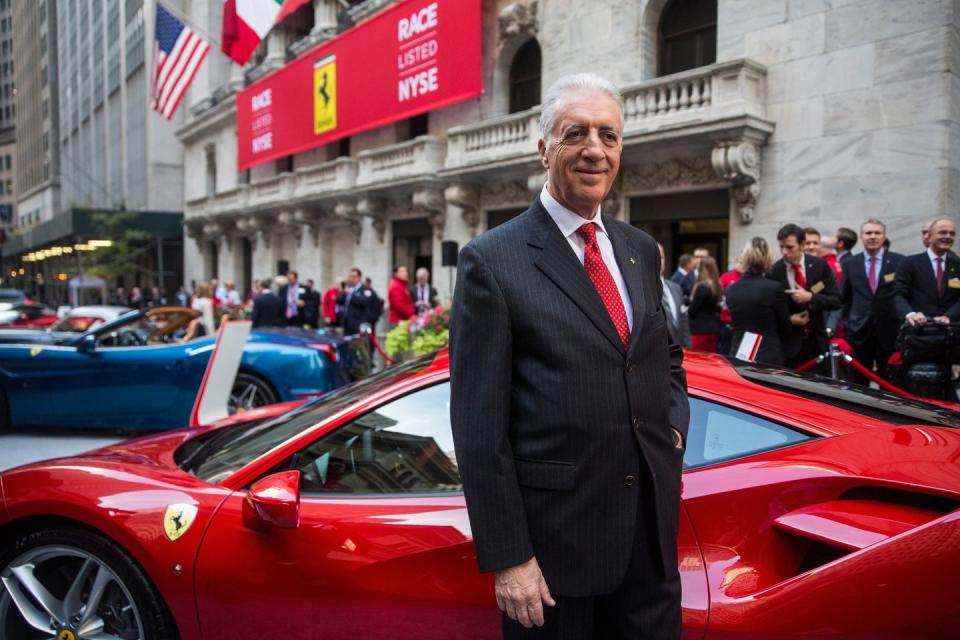The ‘Ferrari’ Movie Is Set In One of the Most Disastrous Years of the Italian Automaker’s Life
- Oops!Something went wrong.Please try again later.
- Oops!Something went wrong.Please try again later.

"Hearst Magazines and Yahoo may earn commission or revenue on some items through these links."
The Ferrari brand is synonymous with success on the race track and luxury on the roadways. However, there was a time when legendary figurehead Enzo Ferrari and his company were speeding toward an ignominious fate.
This turbulent part of the Italian automaker’s history is the focus of the new movie Ferrari, which stars Adam Driver as the titular founder. Now in theaters, the biopic also features Penélope Cruz as Ferrari’s wife, Laura, and Shailene Woodley as his mistress, Lina Lardi.
Ferrari received a seven-minute standing ovation after its premiere at the Venice Film Festival in late August and is still generating buzz upon its wide release. The film is included on the Academy Awards shortlists for sound and makeup and hairstyling.
The movie is set in 1957, with Ferrari’s personal and business life both eroding amid revelations of a love child with Lardi and the company steering toward bankruptcy. Undaunted, Ferrari hopes a victory in the 1957 Mille Miglia, a 1,000-mile race through the streets of Italy, will be the boon his company needs.
In reality, though, the event only added to the turmoil in Ferrari’s life. Here’s what you need to know about the tragedy that unfolded behind the wheel and within the automobile empire at the time.
Humble Beginnings

In his 2009 book Go Like Hell: Ford, Ferrari, and Their Battle for Speed and Glory at Le Mans, journalist A.J. Baime writes that Enzo—born on February 18, 1898 in Modena, Italy—lost his father and brother to the flu amid World War I and was left penniless. Although he was relatively uneducated, he had a talent for fixing things, particularly cars. He became a mechanic and driver for Alfa Romeo in 1923 and, by 1929, founded the Scuderia Ferrari team that became the company’s racing division.
He married Laura Garello in 1923, and they had their only son, Alfredo who went by “Dino,” in January 1932. According to Baime, his son’s birth spurred Ferrari to give up racing himself and build a legacy that would endure beyond his life. But it wouldn’t be with Alfa Romeo, which he left in 1939.
Subscribe to our newsletter so you can always know what’s fact and what’s fiction.
Ferrari decided to invest in his own carmaking company following his tenure with Alfa Romeo and established Auto Avio Costruzioni that same year in Modena. He expanded operations with a new factory in Maranello to produce machine tools during World War II and turned his attention to racing after the conflict. His first car, the 125, debuted in May 1947 and won a race within two weeks. After a win in the 24 Hours of Le Mans in 1949, demand for Ferraris soared across Europe. Thus, the company began offering touring cars, with the first reaching the United States in June 1949.
Behind the scenes, Ferrari’s personal life was less rosy. While he was a devoted father to Dino, he had several affairs throughout his marriage (divorce wasn’t legal in Italy until 1970). According to The Guardian, he began seeing Lardi in the 1920s, and the pair maintained a relationship for decades. They had a son named Piero in 1945. Because of the scandalous nature of their relationship, Piero wasn’t publicly recognized as Ferrari’s child until Laura’s death in 1978.
Still, Enzo carried on with dreams of racing glory. But a personal tragedy put his company’s future in doubt.
A Heartbreaking Loss
Ferrari’s world shattered in June 1956 with the death of his son—with whom he shared an inseparable bond, according to Baime. Dino was 24 years old.
In his early teens, Dino had begun suffering from strange maladies. Doctors eventually diagnosed him with muscular dystrophy, which most historians agree with, though some argue he might have had leukemia or even syphilis passed from his mother at birth. By 1955, Dino became bedridden with stiff muscles and failing kidneys at the family home in Modena. Enzo kept meticulous notes about his son’s condition, making charts and graphs that tracked his caloric intake and diuresis.
Still, this hadn’t stopped Ferrari from grooming Dino into his carbuilding apprentice. Dino earned an engineering diploma, learned to speak English, and had his own office next to his father’s. Even in his worst condition, he loved speaking to drivers and engineers from the Ferrari team. Allegedly, he helped his father and engineer Vittorio Jano design the revolutionary 1.5-liter racing engine on his deathbed.
Following Dino’s death on June 30, Enzo wrote four final words in his notebook: “The match is lost.” In his office at the factory, he mounted a portrait of his son above a wall light as if building a shrine. It was also during this time he became reclusive and estranged from Laura, according to British GQ.
Devastated, Ferrari claimed racing no longer had meaning and that he would give it up completely. The declaration lasted only six months. In December 1956, Ferrari assembled a seven-driver Grand Prix team with racing stars from around the world and looked ahead to the Mille Miglia.
Tragedy at the Mille Miglia

A Ferrari car did win the treacherous road race but at a terrible cost. On May 12, 1957, driver Alfonso de Portago, a beloved Spanish aristocrat and bobsledding champion driving for Ferrari, had a tire failure in the rural village of Guidizzolo. His car struck a telephone pole and swerved into a crowd of spectators before coming to rest in a ditch.
According to Baime, the impact instantly killed de Portago. Co-driver Edmund Nelson also died, along with nine spectators, including five children. Newspapers the following day printed headlines calling to abolish the race, which had been an Italian staple for three decades.
Enzo was charged with manslaughter and “causing grievous bodily harm by negligence,” Baime wrote. The papers alleged he used racing tires that weren’t equipped to handle the speeds of his cars. Although he was found innocent, the saga would continue to haunt Ferrari and his team for years as more drivers died, including Luigi Musso and Peter Collins in 1958 and Wolfgang von Trips in 1961.
Pretty much all racing cars were unsafe at the time as they grew lighter and lighter—and the idea of wearing a seatbelt, Baime said, was considered unmanly—but Ferrari was seen as the most callous of team leaders. “When you drive for Ferrari, you are headed one way only: for that little box under the ground,” rival driver Harry Schell said in 1959. Hauntingly, Schell died only a year later while practicing for a race at Britain’s Silverstone track.
While the film focuses on one of the most taxing years in Ferrari’s life, his story was far from over. Feeling as though his country had betrayed him by branding him a murderer, he again threatened to quit racing. But, once again, the lure of winning prevented Ferrari from following through.
Ferrari, Post-1950s
By 1961, Ferrari’s racing program had established dominance, winning driver and constructor championships in Formula 1 and the World Sportscar Championship. However, the discontent now came from within the factory walls in Maranello. Reportedly frustrated by Laura’s involvement with company affairs and the bad publicity of each driver death, longtime sales manager Girolamo Gardini threatened to walk out.
An indignant Enzo instead fired Gardini, as well as chief engineer Carlo Chiti, experimental sports car development leader Giotto Bizzarrini, and a handful of others, according to The Pittsburgh Vintage Grand Prix Association. The “Palace Revolt” was thought to be a potential fatal blow at the time, but turned out to be a blessing in disguise.

New engineer Mauro Forghieri and body designer Sergio Scaglietti completed work on the new 250 GTO, which became one of the most famous sportscars in history. On-track success continued, and a 1969 merger with Fiat, which purchased 50 percent of shares, helped stabilize the company financially.
Enzo resigned as president in 1977 and died 11 years later, with Piero assuming control of his father’s remaining stake. He is now the vice chairman and 10 percent owner of the company.
Ferrari is one of the most recognizable brands in the automotive world, selling more than 13,000 luxury cars in 2022 according to company data. But as the film illustrates, there was plenty of hardship along the way.
You Might Also Like

